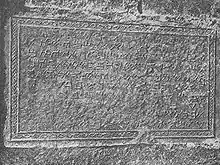| Samaritan | |
|---|---|
 | |
| Script type | |
Time period | 600 BCE – present |
| Direction | right-to-left script, top-to-bottom |
| Languages | Samaritan Hebrew, Samaritan Aramaic |
| Related scripts | |
Parent systems | |
| ISO 15924 | |
| ISO 15924 | Samr (123), Samaritan |
| Unicode | |
Unicode alias | Samaritan |
| U+0800–U+083F | |
The Samaritan script is used by the Samaritans for religious writings, including the Samaritan Pentateuch, writings in Samaritan Hebrew, and for commentaries and translations in Samaritan Aramaic and occasionally Arabic.
Samaritan is a direct descendant of the Paleo-Hebrew alphabet, which was a variety of the Phoenician alphabet. Paleo-Hebrew is the alphabet in which large parts of the Hebrew Bible were originally penned according to the consensus of most scholars, who also believe that these scripts are descendants of the Proto-Sinaitic script. Paleo-Hebrew script was used by the ancient Israelites, both Jews and Samaritans.
The better-known "square script" Hebrew alphabet which has been traditionally used by Jews since the Babylonian exile is a stylized version of the Aramaic alphabet called Ashurit (כתב אשורי), though religious literalist interpretations of Exodus 32:16 assume that the text asserts that it was received on Sinai from the Finger of God and that it has been in continuous and unchanged use since then.
Historically, the Aramaic alphabet became distinct from Phoenician/Paleo-Hebrew in the 8th century BCE. After the fall of the Persian Empire, Judaism used both scripts before settling on the Aramaic form, henceforth de facto becoming the "Hebrew alphabet" since it was repurposed to write Hebrew. For a limited time thereafter, the use of paleo-Hebrew (proto-Samaritan) among Jews was retained only to write the Tetragrammaton, but soon that custom was also abandoned.
A cursive style of the alphabet also exists.
The Samaritan alphabet first became known to the Western world with the publication of a manuscript of the Samaritan Pentateuch in 1631 by Jean Morin.[2] In 1616 the traveler Pietro della Valle had purchased a copy of the text in Damascus, and this manuscript, now known as Codex B, was deposited in a Parisian library.[3]
Development
The table below shows the development of the Samaritan script. On the left are the corresponding Hebrew letters for comparison. Column X shows the modern form of the letters.

Letters

|
Consonants |
Vowels |
Punctuation[4]
|
Unicode
Samaritan script was added to the Unicode Standard in October 2009 with the release of version 5.2.
The Unicode block for Samaritan is U+0800–U+083F:
| Samaritan[1][2] Official Unicode Consortium code chart (PDF) | ||||||||||||||||
| 0 | 1 | 2 | 3 | 4 | 5 | 6 | 7 | 8 | 9 | A | B | C | D | E | F | |
| U+080x | ࠀ | ࠁ | ࠂ | ࠃ | ࠄ | ࠅ | ࠆ | ࠇ | ࠈ | ࠉ | ࠊ | ࠋ | ࠌ | ࠍ | ࠎ | ࠏ |
| U+081x | ࠐ | ࠑ | ࠒ | ࠓ | ࠔ | ࠕ | ࠖ | ࠗ | ࠘ | ࠙ | ࠚ | ࠛ | ࠜ | ࠝ | ࠞ | ࠟ |
| U+082x | ࠠ | ࠡ | ࠢ | ࠣ | ࠤ | ࠥ | ࠦ | ࠧ | ࠨ | ࠩ | ࠪ | ࠫ | ࠬ | ࠭ | ||
| U+083x | ࠰ | ࠱ | ࠲ | ࠳ | ࠴ | ࠵ | ࠶ | ࠷ | ࠸ | ࠹ | ࠺ | ࠻ | ࠼ | ࠽ | ࠾ | |
| Notes | ||||||||||||||||
See also
References
- ↑ Himelfarb, Elizabeth J. "First Alphabet Found in Egypt", Archaeology 53, Issue 1 (Jan./Feb. 2000): 21.
- ↑ Exercitationes ecclesiasticae in utrumque Samaritanorum Pentateuchum, 1631
- ↑ Flôrenṭîn 2005, p. 1: "When the Samaritan version of the Pentateuch was revealed to the Western world early in the 17th century... [footnote: 'In 1632 the Frenchman Jean Morin published the Samaritan Pentateuch in the Parisian Biblia Polyglotta based on a manuscript that the traveler Pietro Della Valle had bought from Damascus sixteen years previously.]"
- ↑ Murtonen, A. (2015). "Materials for a non-Masoretic Hebrew Grammar III: A grammar of the Samatiran dialect of Hebrew". Studia Orientalia Electronica. 29: 1–113. Retrieved 9 January 2024.
Bibliography
- Flôrenṭîn, Moše (2005). Late Samaritan Hebrew: A Linguistic Analysis of Its Different Types. Brill. ISBN 978-900413841-4.